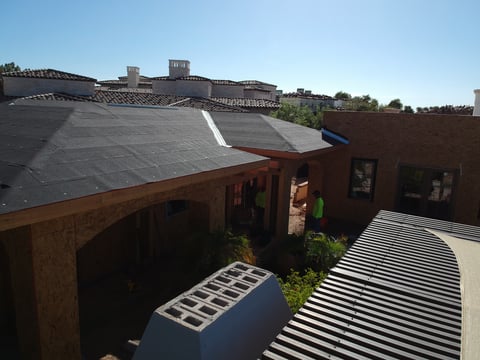by Susan Raisanen | Apr 17, 2024 | Roofing Company Near Me, 2-ply g40 underlayment, tile roofing underlayment, synthetic underlayment, tile roof repair, rubberized asphalt
What is Tile Roof Underlayment?
 Tile roof underlayment is a protective layer installed between the roof deck (the structural surface that supports the roof) and the roofing material (such as tiles). Its primary purpose is to provide an additional barrier against water infiltration and other elements that can damage the roof and the underlying structure.
Tile roof underlayment is a protective layer installed between the roof deck (the structural surface that supports the roof) and the roofing material (such as tiles). Its primary purpose is to provide an additional barrier against water infiltration and other elements that can damage the roof and the underlying structure.
Key Functions of Tile Roof Underlayment:
-
Waterproofing: Underlayment acts as a waterproof barrier, preventing water from seeping into the roof deck and causing damage to the roof structure, insulation, and interior of the building.
-
Secondary Protection: In addition to the primary roofing material (tiles), underlayment provides a secondary layer of protection against leaks, especially in areas where tiles may be damaged or missing.
-
Moisture Control: Underlayment helps control moisture buildup in the roof system, which can lead to mold, mildew, and rot.
-
Enhanced Roof Integrity: By providing an additional layer between the roof deck and the roofing material, underlayment helps enhance the overall integrity and durability of the roof.
-
Temperature Regulation: Some underlayment materials offer thermal insulation properties, helping to regulate the temperature inside the building and reduce energy costs.
-
Protection Against Wind-Driven Rain: Underlayment can help protect the roof from wind-driven rain, which can be particularly important in areas prone to severe weather.
Types of Tile Roof Underlayment:
-
Synthetic Underlayment: Made from polypropylene or other synthetic materials, synthetic underlayment is lightweight, durable, and resistant to tears and punctures. The price point is attractive; however, in order to attach it, nails need to puncture through it and, in our experience and opinion, that disqualifies synthetics as a good option for roofing underlayment.
-
Asphalt-Saturated Felt Underlayment: Also known as felt paper or tar paper, asphalt-saturated felt underlayment has been used for decades in roofing applications. It is a cost-effective option for tile roofs, but not what we would recommend using because it is less durable than some others.
- Rubberized Asphalt: Rubberized asphalt is a type of roofing underlayment that is made by blending asphalt with rubber polymers. This creates a material that is highly flexible, durable, and waterproof. The flexibility of rubberized asphalt allows it to conform to the shape of the roof and provide a seamless barrier against moisture. Rubberized asphalt is especially well-suited for hot climates like Arizona because it can withstand high temperatures without degrading or losing its effectiveness.
Importance of Underlayment in Tile Roofs:
Tile roofs are known for their longevity and durability, but they are not completely waterproof on their own. Without proper underlayment, water can penetrate through gaps in the tiles and cause damage to the roof deck and interior of the building. Underlayment acts as a safeguard, ensuring that even if tiles are damaged or displaced, the roof remains protected against water infiltration.
Tile roof underlayment is a crucial component of a tile roofing system, providing essential protection against water infiltration, moisture buildup, and other elements that can compromise the integrity of the roof. Investing in high-quality underlayment can help prolong the life of your tile roof and protect your home or building against costly repairs.
Call the roofing experts at TraVek Roofing and ask them to come inspect your tile roof. They are prepared to answer all of your roofing questions.
It's not just any roof; it's a TraVek Roof!